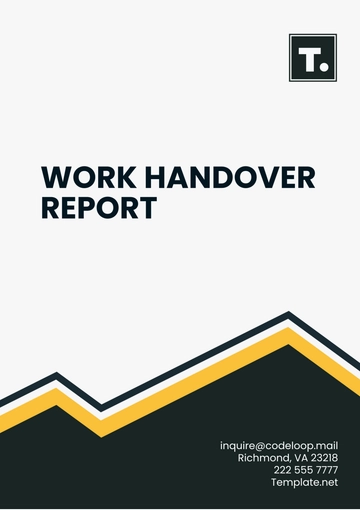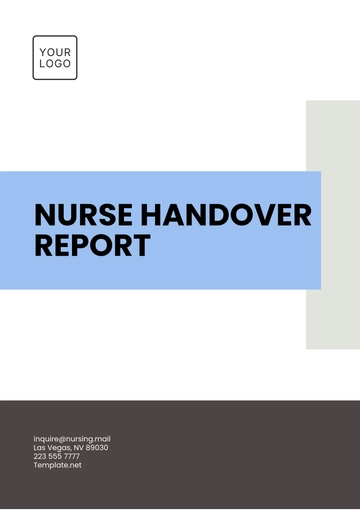Free Restaurant Handover Report

I. Introduction
A. Purpose of the Report
The purpose of the report is multi-fold:
Comprehensive Documentation: The report serves as a comprehensive document that records the current operational status of the restaurant. It provides a detailed account of the restaurant’s financial performance, inventory status, and staff details.
Smooth Transition: The report aims to ensure a smooth transition of management with minimal disruptions. It provides the new management with all the necessary information to take over the operations seamlessly.
Reference Guide: The report serves as a reference guide for the new management. It provides insights into the restaurant’s operations and performance, which can guide the new management in making informed decisions.
B. Scope of the Report
The scope of the report is extensive and covers the following areas:
Financial Performance: The report provides a detailed account of the restaurant’s financial performance. It includes information about the restaurant’s revenue, expenses, and net profit.
Inventory Status: The report includes a comprehensive inventory status. It provides information about the quantity, unit cost, and total value of each item in the inventory.
Staff Details: The report provides detailed information about the staff and their roles. It includes information about their work schedules and contact information.
II. Financial Performance
The financial performance provides insights into the [Your Company Name]'s profitability, cost management, and revenue generation strategies. The following chart and table present the financial performance of the restaurant for the first five months of the year:
Month | Total Revenue | Total Expenses | Net Profit |
|---|---|---|---|
January | $50,000 | $30,000 | $20,000 |
February | $48,000 | $28,000 | $20,000 |
March | $52,000 | $29,000 | $23,000 |
April | $49,000 | $27,500 | $21,500 |
May | $53,000 | $30,500 | $22,500 |
A. Revenue Analysis
The revenue generated by the restaurant is a direct reflection of its popularity and customer satisfaction. An analysis of the monthly revenues reveals the following:
January marked the start of the year with a strong revenue of $50,000, indicating a robust customer base and effective marketing strategies.
February saw a slight dip in revenue to $48,000. This could be attributed to seasonal factors or market trends.
March showed an increase in revenue to $52,000, suggesting successful promotional campaigns or menu changes.
April’s revenue dropped slightly to $49,000. This could be due to factors such as holiday seasons or changes in customer preferences.
May saw the highest revenue of the period at $53,000, indicating a successful spring season for the restaurant.
B. Expense Analysis
The expenses incurred by the restaurant provide insights into its cost management strategies. A detailed analysis of the monthly expenses reveals the following:
January and May had the highest expenses at $30,000 and $30,500 respectively, possibly due to higher operational costs or investments in marketing campaigns.
February and April saw a decrease in expenses to $28,000 and $27,500 respectively, indicating effective cost management strategies.
March had a moderate increase in expenses to $29,000, which could be attributed to seasonal factors or investments in staff training.
C. Profit Analysis
The net profit of the restaurant is a key indicator of its financial health and operational efficiency. An analysis of the monthly net profits reveals the following:
January and February had the same net profit of $20,000, indicating consistent performance.
March saw the highest net profit of $23,000, reflecting effective cost management and revenue generation strategies.
April had a net profit of $21,500, indicating a slight dip in performance.
May ended with a net profit of $22,500, reflecting a successful spring season.
D. Overall Financial Performance
The overall financial performance of the restaurant has been consistent over the period with a steady increase in net profit. This indicates effective cost management and revenue generation strategies. The financial performance of the restaurant is a critical factor in its long-term success. It provides insights into the restaurant’s operational efficiency, profitability, and strategic planning. The detailed analysis of the restaurant’s financial performance can guide the new management in making informed decisions and implementing effective strategies for future growth.
III. Inventory Status
The inventory status provides insights into the restaurant’s supply chain management, cost control strategies, and menu planning. The following table provides a detailed account of the current inventory status. It includes the quantity, unit cost, and total value of each item:
Item | Quantity | Unit Cost | Total Value |
|---|---|---|---|
Chicken (lbs) | 500 | $2.00 | $1000 |
Beef (lbs) | 300 | $3.00 | $900 |
Pasta (lbs) | 200 | $1.50 | $300 |
Wine (bottles) | 150 | $10.00 | $1500 |
Vegetables (lbs) | 400 | $1.00 | $400 |
A. Chicken Inventory
The restaurant has 500 lbs of chicken in stock, with a unit cost of $2.00, amounting to a total value of $1000. This indicates a sufficient supply of chicken, which is a staple ingredient in many dishes. The cost-effective pricing of the chicken also contributes to the restaurant’s profitability.
B. Beef Inventory
The beef inventory stands at 300 lbs, with a unit cost of $3.00, giving a total value of $900. This suggests that beef is another key ingredient in the restaurant’s menu. The moderate pricing of the beef indicates a balance between cost control and quality assurance.
C. Pasta Inventory
There are 200 lbs of pasta in stock, with a unit cost of $1.50, amounting to a total value of $300. This reflects the restaurant’s focus on offering a variety of dishes, including pasta-based options. The relatively low cost of pasta contributes to the restaurant’s cost efficiency.
D. Wine Inventory
The restaurant has 150 bottles of wine, with a unit cost of $10.00, giving a total value of $1500. This suggests that the restaurant offers a selection of wines to complement its dishes. The pricing of the wine reflects the restaurant’s emphasis on providing quality beverages to its customers.
E. Vegetable Inventory
The vegetable inventory stands at 400 lbs, with a unit cost of $1.00, amounting to a total value of $400. This indicates the restaurant’s commitment to offering fresh and healthy options. The cost-effective pricing of the vegetables contributes to the restaurant’s overall cost management strategy.
F. Overall Inventory Status
The inventory status provides a clear picture of the restaurant’s stock levels. This information is crucial for planning and managing the restaurant’s operations effectively. It provides insights into the restaurant’s supply chain management, cost control strategies, and menu planning. The detailed analysis of the inventory status can guide the new management in optimizing the restaurant’s operations and improving its profitability. The new management should pay close attention to the inventory status and make necessary adjustments to ensure the restaurant’s ongoing success.
IV. Staff Details
The staff of a restaurant plays a crucial role in its operations and success. They are the ones who interact with the customers, prepare the food, and manage the operations. The following table provides details about the staff, their roles, work schedules, and contact information:
Role | Staff Name | Work Schedule | Contact Information |
|---|---|---|---|
Head Chef | John Grey | Mon-Fri, 9 AM - 5 PM | john@email.com |
Sous Chef | Jane Smith | Mon-Fri, 9 AM - 5 PM | |
Waitress | Emily Davis | Wed-Sun, 11 AM - 7 PM | |
Bartender | Michael Brown | Thu-Sun, 4 PM - 12 AM | |
Manager | Sarah Wilson | Mon-Fri, 9 AM - 6 PM |
A. Head Chef
John Grey is the Head Chef. He works from Monday to Friday, 9 AM - 5 PM. As the Head Chef, John is responsible for overseeing the kitchen operations, planning the menu, and ensuring the quality of the food. His role is critical in maintaining the restaurant’s reputation and customer satisfaction.
B. Sous Chef
Jane Smith is the Sous Chef. She also works from Monday to Friday, 9 AM - 5 PM. The Sous Chef is the second in command in the kitchen and assists the Head Chef in managing the kitchen operations. Jane’s role is crucial in ensuring the smooth functioning of the kitchen and maintaining the quality of the food.
C. Waitress
Emily Davis is a waitress. She works from Wednesday to Sunday, 11 AM - 7 PM. As a waitress, Emily is responsible for taking orders, serving food, and interacting with the customers. Her role is vital in providing excellent customer service and enhancing the dining experience of the customers.
D. Bartender
Michael Brown is the bartender. He works from Thursday to Sunday, 4 PM - 12 AM. The bartender is responsible for preparing and serving drinks to the customers. Michael’s role is important in enhancing the restaurant’s beverage offerings and providing a pleasant dining experience to the customers.
E. Manager
Sarah Wilson is the Manager. She works from Monday to Friday, 9 AM - 6 PM. The Manager is responsible for overseeing the restaurant’s operations, managing the staff, and ensuring customer satisfaction. Sarah’s role is critical in ensuring the smooth functioning of the restaurant and its overall success.
The staff details provide a clear understanding of the roles and responsibilities of each staff member. This information is crucial for effective management and coordination of restaurant operations. The new management can use this information to understand the staffing structure of the restaurant and plan accordingly. The staff is the backbone of the restaurant, and their performance directly impacts the restaurant’s success. Therefore, it is important for the new management to invest in staff training and development to ensure high-quality service and customer satisfaction.
V. Conclusion
This handover report serves as a comprehensive guide that encapsulates the vital aspects of the restaurant operations managed by [Your Company Name]. It provides a detailed overview of the financial performance, inventory status, and staff details, thereby ensuring a seamless transition with minimal disruptions.
The information provided herein is not just a record of the past and present, but also a roadmap for the future. It is designed to guide the new management towards ongoing success and improved performance of the restaurant. The insights and data contained in this report will be instrumental in shaping strategic decisions and operational policies, ultimately contributing to the restaurant’s growth and success under new management.
- 100% Customizable, free editor
- Access 1 Million+ Templates, photo’s & graphics
- Download or share as a template
- Click and replace photos, graphics, text, backgrounds
- Resize, crop, AI write & more
- Access advanced editor
Streamline transitions in your restaurant with ease with the Restaurant Handover Report Template only here on Template.net! This versatile and editable template ensures all critical information is transferred effectively. The customizable format allows for detailed documentation, and the AI Editor Tool aids in creating professional and thorough handover reports immediately!
You may also like
- Sales Report
- Daily Report
- Project Report
- Business Report
- Weekly Report
- Incident Report
- Annual Report
- Report Layout
- Report Design
- Progress Report
- Marketing Report
- Company Report
- Monthly Report
- Audit Report
- Status Report
- School Report
- Reports Hr
- Management Report
- Project Status Report
- Handover Report
- Health And Safety Report
- Restaurant Report
- Construction Report
- Research Report
- Evaluation Report
- Investigation Report
- Employee Report
- Advertising Report
- Weekly Status Report
- Project Management Report
- Finance Report
- Service Report
- Technical Report
- Meeting Report
- Quarterly Report
- Inspection Report
- Medical Report
- Test Report
- Summary Report
- Inventory Report
- Valuation Report
- Operations Report
- Payroll Report
- Training Report
- Job Report
- Case Report
- Performance Report
- Board Report
- Internal Audit Report
- Student Report
- Monthly Management Report
- Small Business Report
- Accident Report
- Call Center Report
- Activity Report
- IT and Software Report
- Internship Report
- Visit Report
- Product Report
- Book Report
- Property Report
- Recruitment Report
- University Report
- Event Report
- SEO Report
- Conference Report
- Narrative Report
- Nursing Home Report
- Preschool Report
- Call Report
- Customer Report
- Employee Incident Report
- Accomplishment Report
- Social Media Report
- Work From Home Report
- Security Report
- Damage Report
- Quality Report
- Internal Report
- Nurse Report
- Real Estate Report
- Hotel Report
- Equipment Report
- Credit Report
- Field Report
- Non Profit Report
- Maintenance Report
- News Report
- Survey Report
- Executive Report
- Law Firm Report
- Advertising Agency Report
- Interior Design Report
- Travel Agency Report
- Stock Report
- Salon Report
- Bug Report
- Workplace Report
- Action Report
- Investor Report
- Cleaning Services Report
- Consulting Report
- Freelancer Report
- Site Visit Report
- Trip Report
- Classroom Observation Report
- Vehicle Report
- Final Report
- Software Report





























